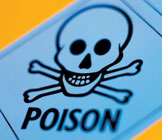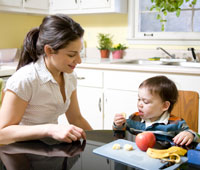Skip section navigation (navigation may have changed)
Section navigation
The environment and your health
Chemicals
Chemicals (say: KEM-ih-calls) are all around us. They can be solids, liquids, or gases. Water is a chemical. Bleach is also a chemical. Sometimes chemicals come from nature (like lead) and sometimes they are made in a factory (like bug spray).
A poison is anything that could make you sick if you eat, drink, smell, or touch it. Poisons come in all shapes, sizes, and forms. Many things in your house can be poisonous. Poisons can also come from things that are common in the environment, like lead or mercury. Medicines, cosmetics, car products, cleaning supplies, arts and crafts materials, food that is improperly prepared or stored, and plants are just a few things in your home that can cause poisonings.
So what is the difference between a chemical and a poison? Well, not all chemicals are poisonous, and not all poisons are chemicals. For example, mushrooms can be poisonous, but they are not a chemical. Poisons can hurt you, and can cause health problems in a very short amount of time. This can be true of chemicals, too, but chemicals can also have effects that last a very long time (even decades). There are many things (like medicines or mouthwash) that are not poisonous when used the right way. But, when used the wrong way, these things can poison you.


Poison Emergency Number
If you think someone has been poisoned, call 1-800-222-1222 right away! Do not wait for the person to look or act sick. The Poison Center will tell you what to do.

What kinds of things can be poisons?
Some poisons come from chemicals that may be found in and around the home. Other poisons in the home may be pills or vitamins. They include:
- Medicines
- Cleaning products
- Laundry products
- Batteries
- Cigarettes
- Mouthwash
- Lighter fluid
- Iron pills and other vitamins
- Bug and weed killers
Some poisons may be found naturally in the environment:
- Lead
- Mercury
- Plants and mushrooms
All of these things can hurt you, especially in high doses. Learn more about the health effects of some chemicals.

Why do babysitters and teens need to know about poison?
 Do you babysit? Or do you have younger brothers or sisters? Then you need to learn about poisons.
Do you babysit? Or do you have younger brothers or sisters? Then you need to learn about poisons.
Poisoning is one of the most common childhood injuries. Most of the time poisoning happens right at home. Children who are between the ages of eight months and six years old are the most likely to be poisoned.
Poisons can look like things that are good to eat and drink. They can come in many colors and forms including solids, liquids, sprays, or gases. Young children are curious. They like to put things in their mouth, especially if they look colorful or smell nice. If you babysit or help with small children, remember to watch them very closely and to keep all poisons locked up and out of reach.

Content last updated July 20, 2010




